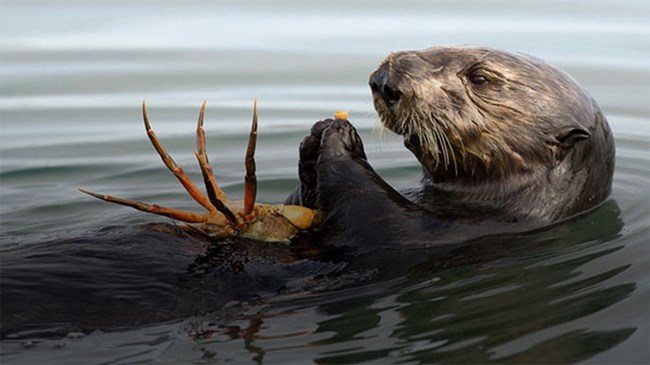Last updated: January 15, 2025
Article
Sea Otter Prey Selection in a Rapidly Expanding Population

This study linked two long-term monitoring data sets: sea otter foraging observations (prey number, species, and size) and estimates of local sea otter density from aerial surveys to demonstrate how sea otter diet has changed in space and time as a function of local sea otter abundance. These long-term monitoring data have been collected since the early 1990s by biologists from the U.S. Geological Survey Alaska Science Center, U.S. Fish and Wildlife Service, and the National Park Service and provide important data streams for understanding how sea otter foraging behavior and diet changes with increases in sea otter density and abundance.
Results from this study demonstrate that as the sea otter population established and increased, sea otter diet changed, shifting from large urchins, crabs, and clams to smaller prey including small clams and mussels. By 2019, sea otters throughout the bay were primarily foraging on small prey regardless of the local occupancy history. Results from this study suggest an interaction between the availability of prey and sea otter prey preference, which is dependent upon bottom-up variation in environmental conditions, and the effects of sea otter predation over time. Collectively, the reoccupation of sea otters across their range in the North Pacific provides a unique opportunity to understand how sea otters influence nearshore communities. This study also demonstrates the value of long-term monitoring of a keystone predator and associated prey communities.
The dynamics of sea otter prey selection under population growth and expansion
Abstract
Sea otters (Enhydra lutris) were extirpated from much of their range in the North Pacific by the early 1900s but have made a remarkable recovery in Southeast Alaska. Sea otter populations have been particularly successful in Glacier Bay, Alaska, a protected tidewater glacier fjord with a diverse and productive nearshore habitat. Collection of sea otter foraging observations in Glacier Bay began in 1993, along with high-resolution aerial surveys that provide estimates of sea otter abundance and distribution. We integrated these two data sources to investigate how sea otter diet changed in space and time as sea otters established and spread across Glacier Bay. Specifically, we developed a multilevel Bayesian model to capture how sea otter diet at a location (the number, type, and size of prey collected) changed as a function of local cumulative otter abundance and the year in which the location was first occupied. This framework enabled us to estimate the sequence of sea otter prey selection and switching as prey populations responded to sea otter foraging pressure. We found that local sea otter diet changed substantially as the population established, shifting away from large urchins, crabs, and clams to Modiolus mussels and small urchins, and lastly to small clams and Mytilus mussels. We also found that sea otter diet at newly occupied sites changed as otters spread over the main channel and into the arms of Glacier Bay. Further, by 2019, sea otters across the bay were primarily foraging on small prey, regardless of the local occupancy history. The absence of a spatial gradient in the size of prey captured late in the study suggests that feedbacks between the top-down effects of sea otter foraging, sea otter dispersal processes, and local variation in habitat productivity may have homogenized the size structure of available prey across Glacier Bay.Leach, C. B., B. P. Weitzman, J. L. Bodkin, D. Esler, G. G. Esslinger, K. A. Kloecker, D. H. Monson, J. N. Womble, and M. B. Hooten. 2024. The dynamics of sea otter prey selection under population growth and expansion. Ecosphere 15(12): e70084.
